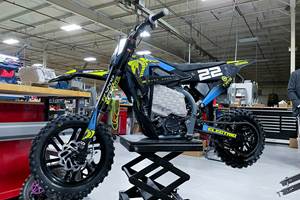Siemens Expands U.S. Additive Manufacturing Initiatives
Company says it is increasing its focus on additive manufacturing research and development to help accelerate transformation of American manufacturing.
Siemens Additive Manufacturing says its technologies help American industry reimagine their products, reinvent their manufacturing and rethink their business. Photo Credit: Siemens
Siemens says it is expanding its focus on additive manufacturing (AM) initiatives in the U.S. to help accelerate the transformation of the U.S. industry through serial additive manufacturing.
“We are on the threshold of a new frontier in American industry, where the implementation of additive manufacturing will bring fundamental changes to the landscape, end-to-end, from product to machine to manufacturing,” says Steve Vosmik, head of Siemens Additive Manufacturing in the U.S. “Siemens is very excited to be at the forefront of this process.”
Siemens is focused on supporting the domestic AM machine builder community, so it is bringing its motion control, automation hardware, digitalization software and technology capabilities to assist machine builders. From its Charlotte Advanced Technology Collaboration Hub (CATCH) in Charlotte, North Carolina, Siemens aims to act as an ecosystem platform for machine builders, machine users and additive design engineers.
“More than 100 machine builders from around the world are implementing Siemens automation solutions to industrialize their machines,” says Rajas Sukthankar, vice-president, motion control, Siemens Industry Inc. “Now it’s time to support even more customers and accelerate their transformation from single machines to series additive manufacturing factories. North America is heading in this direction.”
Siemens says it can assist AM job shops as well as Tier One production facilities with end-to-end solutions, including product design software, digital twin machine simulation and virtual execution of manufacturing methods with full data feedback into the design protocol for necessary adjustments, prior to any machine building. “This comprehensive suite of software and motion control hardware offerings makes Siemens a viable partner at every step of the AM process,” Vosmik adds.
Siemens is adding technology to CATCH to incorporate metal binder jet technology through the purchase and installation of an ExOne/Desktop Metal Production System and Meltio Robotic System with the Siemens Sinumerik RunMyRobot application onboard. Sinumeik RunMyRobot controls the kinematic path of an industrial robot as it integrates with the CNC machine.
Siemens is also establishing an AM Advisory Board of industry leaders, drawn from various industries and technical disciplines, to provide the company guidance as it seeks to support the fast-growing needs of the AM market. “We are looking forward to engaging and collaborating with this talented group of industry experts as we move ahead together into this exciting new world of manufacturing in America,” Vosmik says.
Visit the Siemens Additive Manufacturing website to learn how Siemens is accelerating transformation in the manufacturing industry.
- Read about how Senvol is commercializing Siemens Energy’s material databases for Ti64, Inconel 625 and Inconel 718 for use on laser powder bed fusion machines. Although the data was initially intended exclusively for internal use, the company recently decided to make the data commercially available.
- Learn how HP says it is pushing the limits of workflow automation on the AM factory floor by working closely with long-standing partner Siemens on a proof-of-concept demonstration.
- Check out this article on a 3D printed heat exchanger that illustrates Siemens’ CATCH and release approach. The solutions for energy efficiency, sustainability, part repair and more are developing at Siemens’ Charlotte Advanced Technology Collaboration Hub (CATCH) in North Carolina.
Related Content
Aluminum Gets Its Own Additive Manufacturing Process
Alloy Enterprises’ selective diffusion bonding process is specifically designed for high throughput production of aluminum parts, enabling additive manufacturing to compete with casting.
Read MoreAt General Atomics, Do Unmanned Aerial Systems Reveal the Future of Aircraft Manufacturing?
The maker of the Predator and SkyGuardian remote aircraft can implement additive manufacturing more rapidly and widely than the makers of other types of planes. The role of 3D printing in current and future UAS components hints at how far AM can go to save cost and time in aircraft production and design.
Read MoreNew Electric Dirt Bike Is Designed for Molding, but Produced Through 3D Printing (Includes Video)
Cobra Moto’s new all-electric youth motocross bike could not wait for mold tooling. Parts have been designed so they can be molded eventually, but to get the bike to market, the production method now is additive manufacturing.
Read MoreWhat Does Additive Manufacturing Readiness Look Like?
The promise of distributed manufacturing is alluring, but to get there AM first needs to master scale production. GKN Additive’s Michigan facility illustrates what the journey might look like.
Read MoreRead Next
Looking to Secure the Supply Chain for Castings? Don't Overlook 3D Printed Sand Cores and Molds
Concerns about casting lead times and costs have many OEMs looking to 3D print parts directly in metal. But don’t overlook the advantages of 3D printed sand cores and molds applied for conventional metal casting, says Humtown leader.
Read MoreVideo: Intelligent Layering Metal 3D Printing at 3DEO
Contract manufacturer 3DEO delivers metal parts using Intelligent Layering, a binder jetting-like 3D printing process the company developed and operates internally. Here’s how it works.
Read More3D Printing Brings Sustainability, Accessibility to Glass Manufacturing
Australian startup Maple Glass Printing has developed a process for extruding glass into artwork, lab implements and architectural elements. Along the way, the company has also found more efficient ways of recycling this material.
Read More












.png;maxWidth=300;quality=90)











